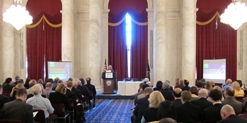
By Aaron Sutch
The White House recently pledged $2 billion for energy efficiency improvements in federal buildings, underscoring efforts already underway to save energy in several government facilities.
The government is the largest user of electricity and fuel in the United States, and buildings account for about 30% of the government’s energy use. To cut down on energy use – as well as save taxpayer money and help the environment – nearly all government agencies are adopting energy efficiency measures.
Energy-Efficient Capitol Buildings The Architect of the Capitol (AOC) is working to decrease energy use in the 65 federal buildings it operates and maintains, including the U.S. Supreme Court, the U.S. Capitol Building, the Library of Congress, and House and Senate office buildings.
In response to the Energy Independence and Security Act of 2007, the AOC assumed responsibility for and implemented a variety of measures to reduce the energy needed to light, heat, cool and operate electronics in Capitol buildings. These measures – which include behavioral campaigns, lighting upgrades and building retrofits – have reaped energy and cost savings. In 2010 alone, the changes saved $124,000, according to Architect of the Capitol Steven Ayers. How is the government doing it? Through building retrofits, efficient lighting and energy performance contracts:
Building Retrofits Retrofits are reducing the energy used to heat, cool and ventilate Capitol buildings. Retrofit measures include:
Sealing ducts and installing draft barriers to eliminate air leakage (which can increase heating and cooling demand). Installing digitally- controlled heating and cooling systems to increase efficiency and maximize occupant comfort. Replacing old equipment and building components with more efficient models, including ENERGY STARappliances. Efficient Lighting and Technology A key strategy in making Capitol buildings more energy efficient has been to upgrade incandescent lighting to fluorescent and LED technologies. For example, after incandescent lights in five Senate hearing rooms were changed to LEDs, the rooms used 80% less electricity. Part of this drop was due to a decreased need for air conditioning to combat hot incandescent bulbs. In addition to LEDs, Capitol buildings are installing:
Dimmable lights High-tech lighting sensors that detect room occupancy and automatically adjust for daylight Software that enables centralized control and monitoring of electricity Energy Performance Contracts Many of the Capitol buildings' energy-efficient upgrades have been accomplished with no up-front investment. Through the use of Energy Savings Performance Contracts, projects are paid for from the savings generated by the installed improvements.
More on Federal Buildings Saving Energy AOC's Sustainability, Energy and Water Conservation Management Report The Alliance to Save Energy's Federal Energy Management Page Federal Sustainability Scorecards: An Overview of a Program "Leading by Example"





